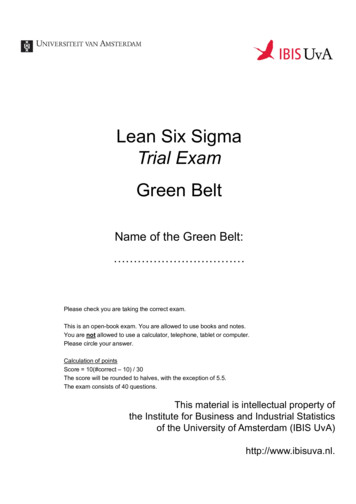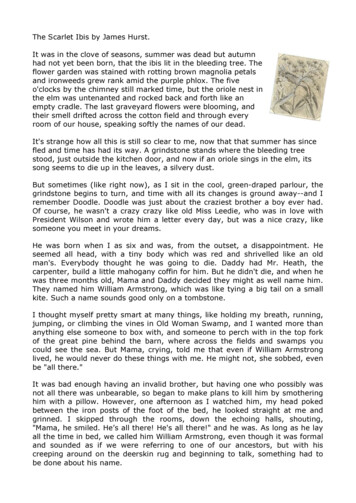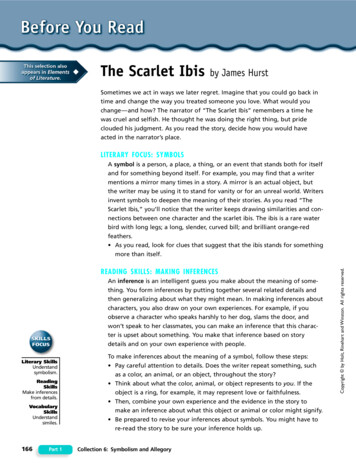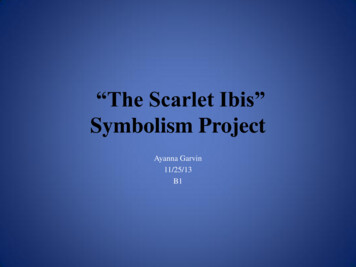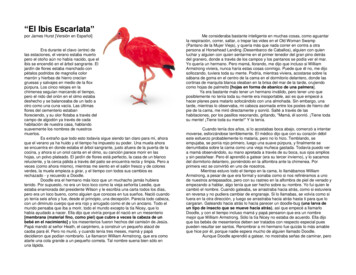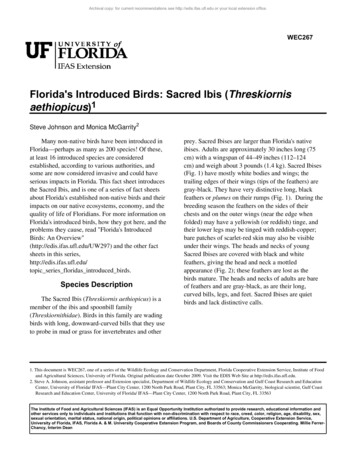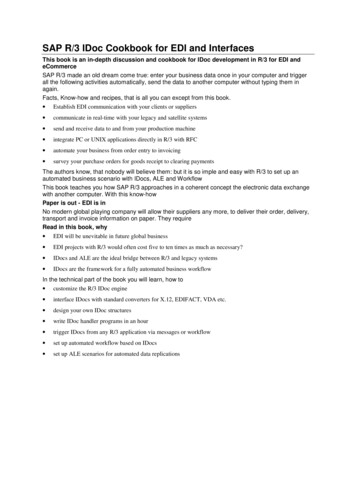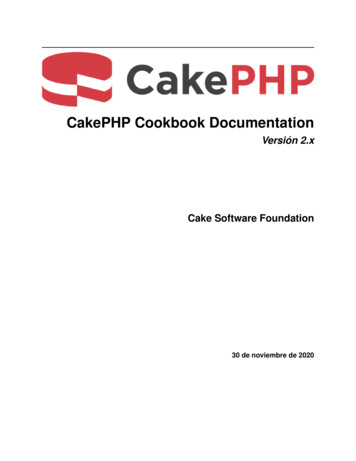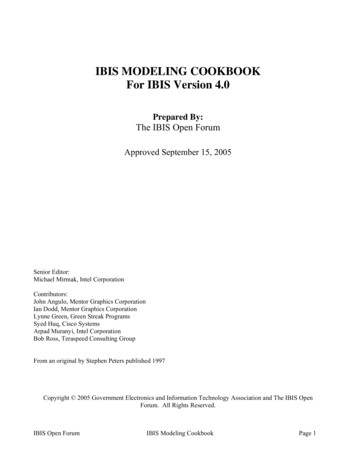
Transcription
IBIS MODELING COOKBOOKFor IBIS Version 4.0Prepared By:The IBIS Open ForumApproved September 15, 2005Senior Editor:Michael Mirmak, Intel CorporationContributors:John Angulo, Mentor Graphics CorporationIan Dodd, Mentor Graphics CorporationLynne Green, Green Streak ProgramsSyed Huq, Cisco SystemsArpad Muranyi, Intel CorporationBob Ross, Teraspeed Consulting GroupFrom an original by Stephen Peters published 1997Copyright 2005 Government Electronics and Information Technology Association and The IBIS OpenForum. All Rights Reserved.IBIS Open ForumIBIS Modeling CookbookPage 1
TABLE OF CONTENTS1.01.11.22.0INTRODUCTION. 6OVERVIEW OF AN IBIS FILE . 6STEPS TO CREATING AN IBIS MODEL . 7PRE-MODELING STEPS. 82.1BASIC DECISIONS . 82.1.1 Model Version and Complexity . 82.1.2 Specification Model versus Part Model . 92.1.3 Minimum and Maximum Corners. 92.1.4 Inclusion of SSO Effects . 92.2INFORMATION CHECKLIST . 102.3COMPONENT BUFFER GROUPING . 113.0EXTRACTING THE DATA – SINGLE-ENDED BUFFERS . 123.1EXTRACTING I-V DATA FROM SIMULATIONS. 123.1.1 Simulation Setup. 123.1.2 Sweep Ranges . 153.1.3 Voltage References . 153.1.4 Diode Models . 163.2EXTRACTING RAMP RATE OR V-T WAVEFORM DATA FROM SIMULATIONS . 173.2.1 Extracting Data for the [Ramp] Keyword. 173.2.2 Extracting Data for the Rising and Falling Waveform Keywords . 183.2.3 Minimum Time Step. 193.2.4 Multi-Stage Drivers. 203.3EXTRACTING BUFFER CAPACITANCE (C COMP). 203.3.1 C comp pullup, C comp pulldown, C comp power clamp, and C comp gnd clamp . 213.4OBTAINING I-V AND SWITCHING INFORMATION VIA LAB MEASUREMENT . 224.0EXTRACTING THE DATA – DIFFERENTIAL BUFFERS. 244.1INTRODUCTION . 244.2DIFFERENTIAL RECEIVERS . 264.3DIFFERENTIAL DRIVERS . 284.4ON-DIE TERMINATION . 314.5DIFFERENTIAL BUFFER MODELING WITH IBIS . 324.6DATA EXTRACTION . 344.6.1 Extracting Common Mode I-V Tables. 344.6.2 Extracting the Differential Mode I-V Surfaces. 364.6.3 Separating the On-die Termination I-V Tables . 384.6.4 Extracting V-T Table Data . 394.6.5 Additional Notes on Differential Data Extraction. 404.7C COMP AND DIFFERENTIAL BUFFER CAPACITANCE (C DIFF). 415.0PUTTING THE DATA INTO AN IBIS FILE. 445.1BASIC SYNTAX: KEYWORDS AND THEIR DEFINITIONS. 445.1.1 IBIS File Header Information . 445.1.2 Component and Pin Information. 455.1.3 The [Model] Keyword . 465.2DATA CHECKING . 605.2.1 Data Completeness. 605.2.2 I-V and V-T Matching . 605.3DATA LIMITING . 635.4ADDITIONAL RECOMMENDATIONS . 64Page 2IBIS Modeling CookbookIBIS Open Forum
5.4.1 Internal Parallel Terminations. 655.4.2 V-T Table Windowing. 705.5ADVANCED KEYWORDS AND CONSTRUCTS . 705.5.1 [Model Selector] . 705.5.2 [Submodel] . 715.5.3 [Model Spec] . 725.5.4 [Diff Pin] . 735.5.5 [Driver Schedule]. 745.5.6 [Pin Mapping]. 775.5.7 Series Elements. 805.5.8 [Test Data] and Reference Waveforms . 846.0VALIDATING THE MODEL . 857.0CORRELATING THE DATA. 868.0RESOURCES . 87IBIS Open ForumIBIS Modeling CookbookPage 3
INDEX OF FIGURESFigure 3.1 – Standard 3-state Buffer (Pulldown I-V Table Extraction Shown). 13Figure 3.2 – Simulation Setup for Extracting Ramp Rate Information (Rising Edge Shown) . 18Figure 3.3 – Fixture for Extraction of C comp Information. 20Figure 3.4 – Surface Plot of Buffer Capacitance versus Frequency and DC Bias Voltage. 21Figure 3.5 – Fixture for Extraction of C comp Information. 22Figure 4.1 – Device with Independent Input, Output and Power Supply Ports . 24Figure 4.2 – Device with Ports Using Common Ground . 25Figure 4.3 – Input Port with Locally Generated Reference . 25Figure 4.4 – Single-ended Receiver . 26Figure 4.5 – Fully Differential Receiver . 27Figure 4.6 – Half-differential Receiver . 27Figure 4.7 – Pseudo-differential Receiver. 28Figure 4.8 – Single-ended Driver. 29Figure 4.9 – Fully Differential Driver with External Load . 29Figure 4.10 – Half-differential Driver with External Load . 30Figure 4.11 – Pseudo-differential Driver Example . 31Figure 4.12 – Block Diagram of a Fully Differential Model using IBIS Version 3.2 Constructs . 33Figure 4.13 – I-V Table Extraction Fixture for a Differential Buffer . 35Figure 4.14 – Surface Plots of Raw Data from I-V Sweep of Differential Buffer. 35Figure 4.15 – I-V Curves of Common Mode Characteristics of Differential Buffer . 36Figure 4.16 – Differential Current Plot of Output Current versus P and N Voltage. 36Figure 4.17 – Plots of Various Vds Values for a [Series MOSFET] Buffer . 38Figure 4.18 – V-T Table Extraction Fixture for a Differential Buffer . 40Figure 4.19 – Fixture for Extraction of Differential Buffer C comp. 42Figure 4.20 – Surface Plot of Differential Capacitance versus Frequency and DC Bias Voltage . 43Figure 5.1 – Conceptual Diagram of Model Keyword Structure . 49Figure 5.2 – Model Keyword Structure with Added Diode Detail . 49Figure 5.3 – Raw I-V and Final [GND Clamp] Data Graphs. 52Figure 5.4 – Graph of [GND Clamp] I-V Table Data . 52Figure 5.5 – Raw I-V and Final [POWER Clamp] Data Graphs . 53Figure 5.6 – Graph of [POWER Clamp] I-V Table Data after Clamp Subtraction . 54Figure 5.7 – Graph of [Pulldown] I-V Table Data, after Clamp Subtraction. 55Figure 5.8 – Graph of [Pullup] I-V Table Data after Clamp Subtraction. 55Figure 5.9 – Diagram of Resistive Load for Rising Waveform . 61Figure 5.10 – V-T Table Loading Example . 61Figure 5.11 – V-T Table Loading Example, Simplified . 62Figure 5.12 – [Pullup] I-V Table Data with Load Line Intercept . 63Figure 5.13 – Data Point Selection Example . 64Figure 5.14 – Diagram of I/O Buffer with Internal Termination . 65Figure 5.15 – Graph of Power and Ground Clamp I-V Data for Ground-connected Termination . 66Figure 5.16 – Graph of I-V Data for Ground-connected Termination in High-Impedance State . 67Figure 5.17 – Graph of Power and Ground Clamp I-V Data for Vcc-connected Termination . 68Figure 5.18 – Graph of I-V Data for Vcc Terminated Buffer in High-Impedance State . 69Figure 5.19 - Block Diagram of a Two-Tap Differential Buffer Featuring Pre-Emphasis . 75Figure 5.20 – Output of a Scheduled Driver Configured as an Inverter . 76Figure 5.21 – Component Diagram Showing Buffer and Supply Buses. 78Figure 5.22 – Connection of Single-ended and Series [Model]s . 80Page 4IBIS Modeling CookbookIBIS Open Forum
INDEX OF TABLESTable 3.1 – Recommended Load Circuits and Waveforms for V-T Data Extraction . 19Table 5.1 – IBIS File Header Keywords . 45Table 5.2 – IBIS Component and Pin Information . 46Table 5.3 – IBIS [Model] Subparameters . 47Table 5.4 – IBIS [Model] Temperature and Voltage Keywords . 48Table 5.5 – [Model] I-V Table Keywords. 50Table 5.6 – Summary of Recommended I-V Table Sweep Ranges . 56Table 5.7 – Poorly Extrapolated [GND Clamp] Table, Typical Corner . 56Table 5.8 – [GND Clamp] Table, Typical Corner, with Improved Extrapolation . 56Table 5.9 – [Ramp] and Waveform Table Keywords . 57Table 5.10 – I-V Table Keywords and Buffer Types. 58Table 5.11 – V-T Fixtures and Buffer Types . 59Table 5.12 – V-T Table Loading Recommendations . 59Table 5.13 - Example V-T Table Data for Rising Waveform. 61IBIS Open ForumIBIS Modeling CookbookPage 5
1.0 IntroductionThis document describes the recommended steps for producing IBIS files for digital integrated circuits (ICs).IBIS (officially, EIA standard 656-A-1999, IEC 62014-1) stands for I/O Buffer Information Specification. IBISmodels provide a standardized way of representing the electrical characteristics of a digital IC’s pins (input,output, I/O buffers and the like) behaviorally, i.e., without revealing the underlying circuit’s structure or processinformation.Note that the basic behavioral information in an IBIS model can be obtained either by direct measurement of thecomponent or transistor level simulation of the component’s buffers. This cookbook describes both methods,though with a strong emphasis on data extraction through simulation. The cookbook is targeted towardsgenerating models for CMOS, GTL and bipolar parts, and applies to models generated for IBIS version 4.0 andearlier. For the most recent version of the specification and other IBIS documents, visit the IBIS web page (seethe Resources section).The intended audience of this document is those responsible for performing the measurements or simulations togather I/O buffer data, as well as those responsible for actual IBIS model creation. Persons involved in SI orsystem level PC board simulations using IBIS files may also benefit by reading this document. Some familiaritywith behavioral modeling of I/O buffers and analog simulation is assumed. Finally, this document does notaddress every keyword or feature of the IBIS specification and should not be considered a substitute for thespecification itself. Readers are strongly encouraged to study closely the details of the IBIS specification.1.1Overview of an IBIS FileAn IBIS file contains, in a human readable ASCII format, the data required to model behaviorally acomponent’s input, output and I/O buffers. Specifically, the data in an IBIS file is used to construct a buffermodel useful for performing signal integrity (SI) simulations and timing analysis of printed circuit boards. Thefundamental information needed to perform these simulations is the buffer’s I-V (current versus voltage) andswitching (output voltage versus time) characteristics. Please note that the IBIS specification does NOT definean executable simulation model – it is a standard for the formatting and transfer of data. As such, thespecification defines what the information included in an IBIS file represents and how it is to be gathered. Itdoes not specify what an analog simulation application does with the data.IBIS models are component-centric. That is, an IBIS file allows one to model an entire component, not just aparticular buffer. Therefore, in addition to the electrical characteristics of a component’s buffers, an IBIS fileincludes the component’s pin-to-buffer mapping, and the electrical parameters of the component’s package.In general, an output or I/O buffer is characterized behaviorally using the following information: The buffer’s output I-V characteristics when the output is in the logic low state The buffer’s output I-V characteristics when the output is in the logic high state The buffer’s output I-V characteristics when the output is forced below ground and above the powersupply rail (referred to as its “beyond the rail” characteristics) The time it takes a buffer’s output to switch logic states (i.e., from low to high and high to low) The buffer’s capacitanceFor an input buffer the required information reduces to: The buffer’s I-V characteristics (including its “beyond the rail” characteristics) The buffer’s capacitancePage 6IBIS Modeling CookbookIBIS Open Forum
The above information is included in an IBIS file using “keywords”. A keyword is a word or phrase surroundedby square brackets. Keywords are followed by either specific parameters or tables of data. For instance, the[Model] keyword would be used to encapsulate the I-V and V-T tables, plus other data, for an individual singleended I/O buffer. Some keywords are required, but most are optional. At a minimum, a valid IBIS filecontains the following data and keywords:1. Information regarding the file itself and name of the component being modeled. This information iscontained under the keywords [IBIS Ver], [File Name], [File Rev], [Component] and [Manufacturer].2. Information about the package’s electrical characteristics and the pin to buffer model mapping (i.e.,which pins are connected to which buffer models). This information is included under the [Package]and [Pin] keywords.3. The data required to model each unique input, output and I/O buffer design on the component. The[Model] keyword introduces the data set for each unique buffer. As described above, buffers arecharacterized by their I-V behaviors and switching characteristics. This information is included usingthe keywords [Pullup], [Pulldown], [GND Clamp], [POWER Clamp] and [Ramp]. In addition, therequired parameters to the [Model] keyword specify a model’s type (Input, Output, I/O, Open drain,etc.) and its input or output capacitance.The details of constructing an IBIS model from data are included in Putting the Data into an IBIS File later inthis document.1.2Steps to creating an IBIS ModelThere are five basic steps to creating an IBIS model of a component:1. Perform the pre-modeling activities. These include deciding on the model’s complexity, determiningthe voltage, temperature and process limits over which the IC operates and the buffer model will becharacterized, and obtaining the component related (electrical characteristics and pin-out) and useinformation about the component. See the chapter titled Pre-Modeling Steps.2. Obtain the electrical (I-V and switching response) data for output or I/O buffers either by directmeasurement or by simulation. See the chapter entitled Extracting the Data. This chapter may also beused by those who are doing the simulations required to gather the data but not actually creating theIBIS file.3. Format the data into an IBIS file. See the chapter titled Putting the Data into an IBIS File.4. Check the file using IBISCHK4. If the model is generated from simulation data, validate the model bycomparing the results from the original analog (transistor level) model against the results of a behavioralsimulator that uses the IBIS file as input data. See the chapter titled Validating the Model.5. When the actual silicon is available (or if the model is from measured data), compare the IBIS modeldata to the measured data. See the chapter titled Correlating the Data.The rest of this cookbook documents these steps in detail.IBIS Open ForumIBIS Modeling CookbookPage 7
2.0 Pre-Modeling Steps2.1Basic DecisionsBefore one creates an I/O buffer model there are several basic questions that must be answered regarding themodel’s complexity, operational limits, and use requirements. Answering these questions requires not onlyknowledge of the buffer’s physical construction, but also knowledge of the final application in which the IC willbe used, and any specific requirement the model users may place on the model. These questions cannot beanswered by the model creator alone; they generally require the involvement of both the buffer designer andmembers of the team responsible for insuring that the I/O buffers are useable in a system environment. Thisteam is referred to as the interconnect simulation team. Together, the model creator and interconnect simulationteam must determine the following: Model Version and Complexity Specification Model versus Part Model Fast and Slow Corner Model Limits Inclusion of SSO Effects2.1.1Model Version and ComplexityBased on the characteristics and construction of the I/O buffer itself, and the model user’s simulator capability,you must decide what IBIS version of the model is most appropriate. Different IBIS versions, as denoted by the[IBIS Ver] keyword, support different features. Additionally, the checking rules used by IBISCHK4 changeslightly with each version. In general, models should use the highest [IBIS Ver] version number supported byIBISCHK4 and by their simulation tools (see Validating the Model). Similarly, following good engineeringpractice, use the simplest model that will suffice.A version 1.1 model describes a buffer using a low state and high state I-V table, along with a linear ramp thatdescribes how fast the buffer switches between states. For standard CMOS buffers with a single stage push-pullor open-drain outputs, a version 2.1 model is the recommended minimum. IBIS version 2.1 adds support fortables of V-T data, in addition to support for ECL and dual-supply buffers, ground bounce from shared powerrails, differential I/O buffers, termination components, and controlled rise-time buffers. A version 2.1 or abovemodel will be required if the I/O buffer has any of the following characteristics: Multiple Supply Rails – A version 2.1 (or higher) model is required if the buffer contains diode effects –from parasitic diodes or electrostatic discharge (ESD) diodes – which are referenced to a different powerrail than the pullup or pulldown transistors, or if the I/O uses more than one supply. Non-Linear Output Switching Waveform – A version 2.1 (or higher) model is required if the I/Obuffer’s output voltage versus time behavior (its V-T behavior) when switching low-to-high or high-tolow cannot be accurately described using a linear ramp rate value. This is the case for GTL technology,or for any buffer that uses “graduated turn on” type technology. In addition, a version 2.1 model description is required if the model maker wishes to enable the user toperform ground bounce simulations by connecting several buffers together on a common supply rail.See the [Pin Mapping] keyword description below.IBIS version 3.2 adds support for an electrical board description format, multi-staged buffers or buffers that mayuse multiple I-V tables and diode transient times, among other features. IBIS version 4.0 extends the maximumnumber of points permitted in V-T tables, supports the inclusion of independent validation data tables and addsmore parameters for expressing “databook” criteria for evaluating buffer performance.Page 8IBIS Modeling CookbookIBIS Open Forum
2.1.2Specification Model versus Part ModelA model can be made to represent a particular existing component or can be made as a representativeencapsulation of the limits of the specification for a class of components. Making a model appropriate for aspecification versus a particular part or design is a major factor in determining if and how much guard-bandingor de-rating a model requires. Generally, a “spec model” is based on an existing part, with the strength and edgerate of the model is adjusted to meet the best and worst case parameters of a particular specification. Forexample, a GTL buffer model for a particular processor may give a worst case Vol of 0.4 V at 36 mA.However, if the GTL specification allows for a worst case Vol of 0.6 V at 36 mA the model’s pulldown tablemay be adjusted (or de-rated) to describe the specification and not just the behavior of an individual part.2.1.3Minimum and Maximum Corn
component or transistor level simulation of the component’s buffers. This cookbook describes both methods, though with a strong emphasis on data extraction through simulation. The cookbook is targeted towards generating models for CMOS, GTL and bipolar parts, and appl
